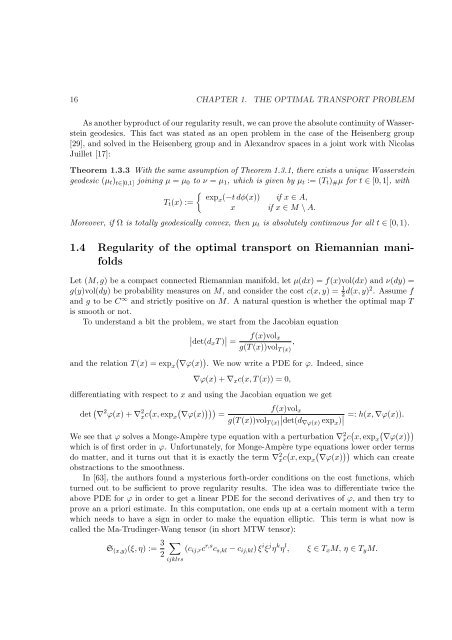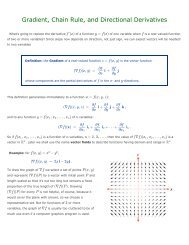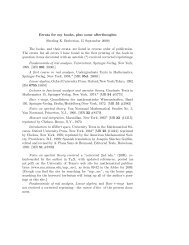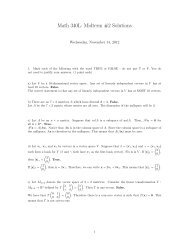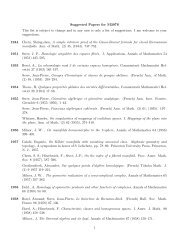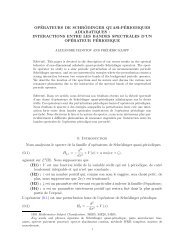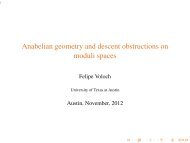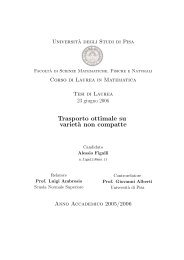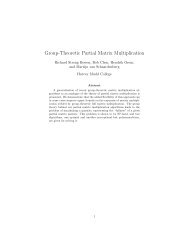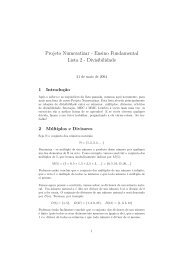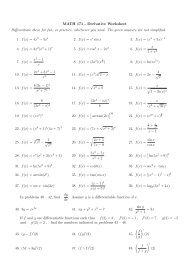Optimal transport, Euler equations, Mather and DiPerna-Lions theories
Optimal transport, Euler equations, Mather and DiPerna-Lions theories
Optimal transport, Euler equations, Mather and DiPerna-Lions theories
You also want an ePaper? Increase the reach of your titles
YUMPU automatically turns print PDFs into web optimized ePapers that Google loves.
16 CHAPTER 1. THE OPTIMAL TRANSPORT PROBLEM<br />
As another byproduct of our regularity result, we can prove the absolute continuity of Wasserstein<br />
geodesics. This fact was stated as an open problem in the case of the Heisenberg group<br />
[29], <strong>and</strong> solved in the Heisenberg group <strong>and</strong> in Alex<strong>and</strong>rov spaces in a joint work with Nicolas<br />
Juillet [17]:<br />
Theorem 1.3.3 With the same assumption of Theorem 1.3.1, there exists a unique Wasserstein<br />
geodesic (µt) t∈[0,1] joining µ = µ0 to ν = µ1, which is given by µt := (Tt)#µ for t ∈ [0, 1], with<br />
<br />
expx(−t dφ(x)) if x ∈ A,<br />
Tt(x) :=<br />
x if x ∈ M \ A.<br />
Moreover, if Ω is totally geodesically convex, then µt is absolutely continuous for all t ∈ [0, 1).<br />
1.4 Regularity of the optimal <strong>transport</strong> on Riemannian manifolds<br />
Let (M, g) be a compact connected Riemannian manifold, let µ(dx) = f(x)vol(dx) <strong>and</strong> ν(dy) =<br />
g(y)vol(dy) be probability measures on M, <strong>and</strong> consider the cost c(x, y) = 1<br />
2 d(x, y)2 . Assume f<br />
<strong>and</strong> g to be C ∞ <strong>and</strong> strictly positive on M. A natural question is whether the optimal map T<br />
is smooth or not.<br />
To underst<strong>and</strong> a bit the problem, we start from the Jacobian equation<br />
<br />
det(dxT ) =<br />
f(x)volx<br />
,<br />
g(T (x))volT (x)<br />
<br />
<strong>and</strong> the relation T (x) = expx ∇ϕ(x) . We now write a PDE for ϕ. Indeed, since<br />
∇ϕ(x) + ∇xc(x, T (x)) = 0,<br />
differentiating with respect to x <strong>and</strong> using the Jacobian equation we get<br />
det ∇ 2 ϕ(x) + ∇ 2 xc <br />
x, expx ∇ϕ(x) =<br />
f(x)volx<br />
<br />
g(T (x))vol det(d T (x) ∇ϕ(x) expx) <br />
=: h(x, ∇ϕ(x)).<br />
We see that ϕ solves a Monge-Ampère type equation with a perturbation ∇2 xc <br />
x, expx ∇ϕ(x)<br />
which is of first order in ϕ. Unfortunately, for Monge-Ampère type <strong>equations</strong> lower order terms<br />
do matter, <strong>and</strong> it turns out that it is exactly the term ∇2 xc <br />
x, expx ∇ϕ(x) which can create<br />
obstractions to the smoothness.<br />
In [63], the authors found a mysterious forth-order conditions on the cost functions, which<br />
turned out to be sufficient to prove regularity results. The idea was to differentiate twice the<br />
above PDE for ϕ in order to get a linear PDE for the second derivatives of ϕ, <strong>and</strong> then try to<br />
prove an a priori estimate. In this computation, one ends up at a certain moment with a term<br />
which needs to have a sign in order to make the equation elliptic. This term is what now is<br />
called the Ma-Trudinger-Wang tensor (in short MTW tensor):<br />
S (x,y)(ξ, η) := 3 <br />
(cij,rc<br />
2<br />
r,s cs,kl − cij,kl) ξ i ξ j η k η l , ξ ∈ TxM, η ∈ TyM.<br />
ijklrs


